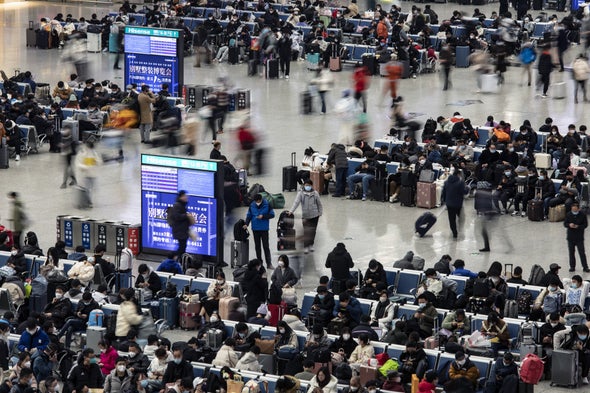Boosting vaccination rates, continuing widespread mask use and reimposing some restrictions on movement could reduce the number of deaths in China’s COVID wave

But these estimates include only deaths due directly to COVID-19, and do not take into account excess deaths because of delays in treating people with non-COVID-19 diseases, says Ewan Cameron, a modeller at the Telethon Kids Institute in Perth, Australia.
The study suggests that if 85% of the population gets a fourth dose of a vaccine other than the inactivated-virus vaccines most people in the country have received, it could slow the rise in infections and reduce the number of severe infections and deaths. Pushing fourth vaccine doses, combined with giving antiviral drugs to people aged 60 and older and to other individuals at high-risk of developing severe disease, could reduce deaths by up to 35%.
“It is really critical for China to achieve the highest vaccination coverage possible in the period immediately before the major epidemic takes off,” says James Trauer, an infectious-disease modeller at Monash University in Melbourne, Australia. He also notes that there is still a lot of uncertainty around the projections about the epidemic’s toll and the impact of measures to slow the spread.
On 13 December, the government announced that people aged 60 and older, and other high-risk groups, should get a fourth dose of vaccine, preferably one based on a different technology from their primary dose. But of the more than 260 million people in China older than 60, only 70% aged 60 and older, and only 40% aged 80 and more, have received a third dose.
Wood notes that it might already be too late for China to benefit from fourth doses because there is already widespread transmission now that many restrictions have been lifted. He is also “not convinced an extra dose will make a big difference to transmission”, because circulating Omicron variants of the virus show a strong ability to evade the body’s immune response.
Fewer deaths
Another model estimates that China will face a COVID-19 death toll of half a million people by April, with 1.6 million deaths by the end of 2023, if the country continues on its current path. The model tracks and forecasts the global burden of COVID-19, and is developed and updated regularly by the Institute for Health Metrics and Evaluation at the University of Washington, Seattle. Deaths in China could rise to close to 9,000 a day by the end of March, says Ali Mokdad, an epidemiologist at the institute.
The model forecasts that the total number of deaths could be reduced to around 290,000 between now and April if China brings in certain measures when the death rate passes a certain threshold. These involve reimposing restrictions, high rates of third- and fourth-dose vaccination and high antiviral drug treatment for at-risk groups. Widespread mask use could reduce deaths still further, to around 230,000. Adherence to masking is high in China, and the eased restrictions have led to changes in behaviour in which people are choosing to restrict their movement, says Mokdad. “They will not [let it] rip.”
The two studies broadly agree on mortality estimates and the impact of interventions, says Cameron. “This similarity in large part reflects an agreement that herd immunity will only be achieved after a large, and difficult to contain, spread of transmission throughout the entire country.”
This article is reproduced with permission and was first published on December 19 2022.
ABOUT THE AUTHOR(S)
Smriti Mallapaty is a senior reporter at Nature.


